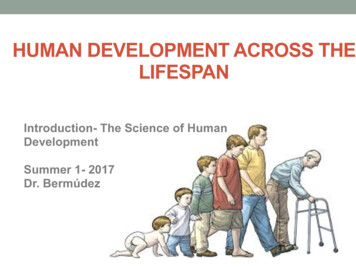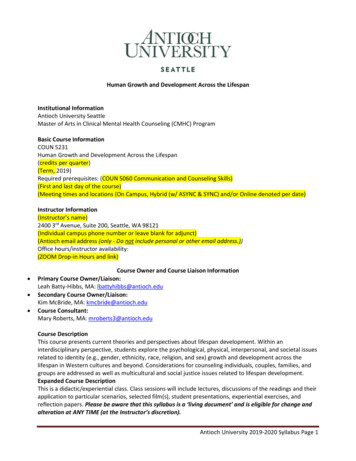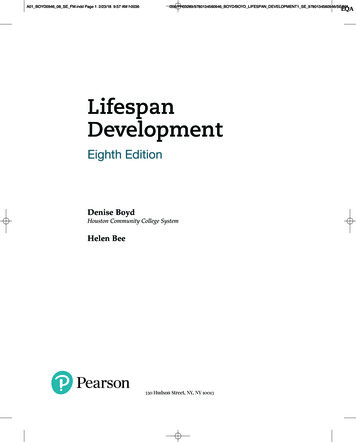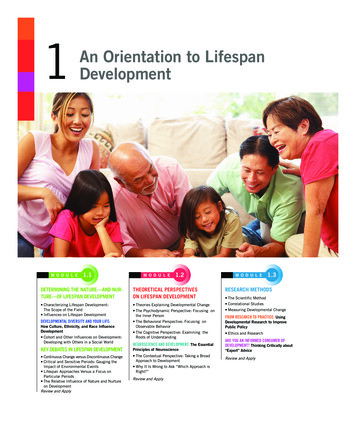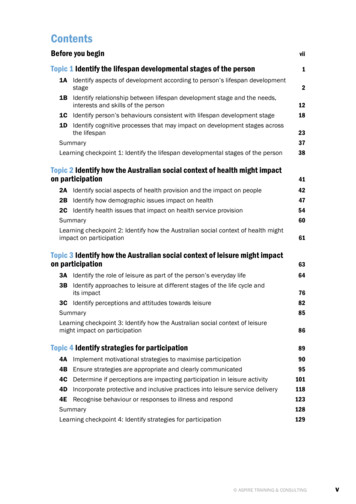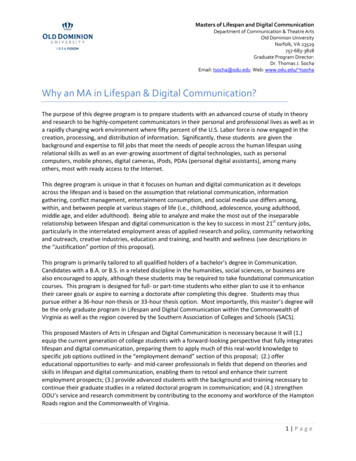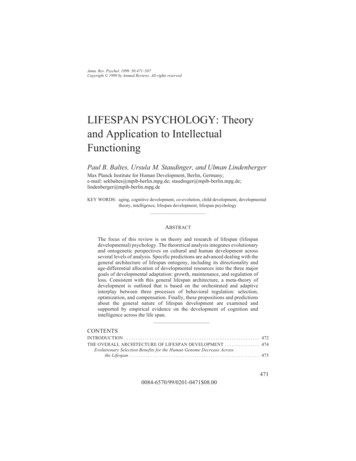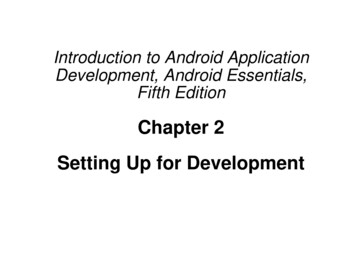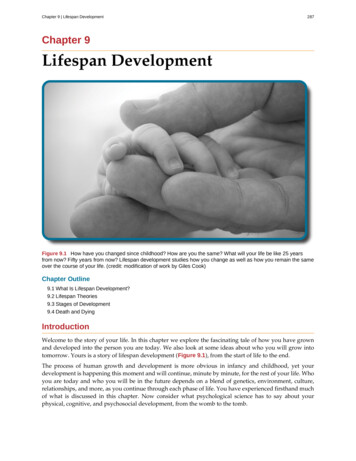
Transcription
Chapter 9 Lifespan Development287Chapter 9Lifespan DevelopmentFigure 9.1 How have you changed since childhood? How are you the same? What will your life be like 25 yearsfrom now? Fifty years from now? Lifespan development studies how you change as well as how you remain the sameover the course of your life. (credit: modification of work by Giles Cook)Chapter Outline9.1 What Is Lifespan Development?9.2 Lifespan Theories9.3 Stages of Development9.4 Death and DyingIntroductionWelcome to the story of your life. In this chapter we explore the fascinating tale of how you have grownand developed into the person you are today. We also look at some ideas about who you will grow intotomorrow. Yours is a story of lifespan development (Figure 9.1), from the start of life to the end.The process of human growth and development is more obvious in infancy and childhood, yet yourdevelopment is happening this moment and will continue, minute by minute, for the rest of your life. Whoyou are today and who you will be in the future depends on a blend of genetics, environment, culture,relationships, and more, as you continue through each phase of life. You have experienced firsthand muchof what is discussed in this chapter. Now consider what psychological science has to say about yourphysical, cognitive, and psychosocial development, from the womb to the tomb.
288Chapter 9 Lifespan Development9.1 What Is Lifespan Development?Learning ObjectivesBy the end of this section, you will be able to: Define and distinguish between the three domains of development: physical, cognitive andpsychosocial Discuss the normative approach to development Understand the three major issues in development: continuity and discontinuity, onecommon course of development or many unique courses of development, and natureversus nurtureMy heart leaps up when I beholdA rainbow in the sky:So was it when my life began;So is it now I am a man;So be it when I shall grow old,Or let me die!The Child is father of the Man;I could wish my days to beBound each to each by natural piety. (Wordsworth, 1802)In this poem, William Wordsworth writes, “the child is father of the man.” What does this seeminglyincongruous statement mean, and what does it have to do with lifespan development? Wordsworth mightbe suggesting that the person he is as an adult depends largely on the experiences he had in childhood.Consider the following questions: To what extent is the adult you are today influenced by the child youonce were? To what extent is a child fundamentally different from the adult he grows up to be?These are the types of questions developmental psychologists try to answer, by studying how humanschange and grow from conception through childhood, adolescence, adulthood, and death. They viewdevelopment as a lifelong process that can be studied scientifically across three developmentaldomains—physical, cognitive, and psychosocial development. Physical development involves growthand changes in the body and brain, the senses, motor skills, and health and wellness. Cognitivedevelopment involves learning, attention, memory, language, thinking, reasoning, and creativity.Psychosocial development involves emotions, personality, and social relationships. We refer to thesedomains throughout the chapter.CONNECT THE CONCEPTSCONNECT THE CONCEPTSResearch Methods in Developmental PsychologyYou’ve learned about a variety of research methods used by psychologists. Developmental psychologists usemany of these approaches in order to better understand how individuals change mentally and physically overtime. These methods include naturalistic observations, case studies, surveys, and experiments, among others.Naturalistic observations involve observing behavior in its natural context. A developmental psychologist mightobserve how children behave on a playground, at a daycare center, or in the child’s own home. While this researchapproach provides a glimpse into how children behave in their natural settings, researchers have very little controlover the types and/or frequencies of displayed behavior.In a case study, developmental psychologists collect a great deal of information from one individual in order tobetter understand physical and psychological changes over the lifespan. This particular approach is an excellentThis OpenStax book is available for free at http://cnx.org/content/col11629/1.5
Chapter 9 Lifespan Development289way to better understand individuals, who are exceptional in some way, but it is especially prone to researcherbias in interpretation, and it is difficult to generalize conclusions to the larger population.In one classic example of this research method being applied to a study of lifespan development Sigmund Freudanalyzed the development of a child known as “Little Hans” (Freud, 1909/1949). Freud’s findings helped informhis theories of psychosexual development in children, which you will learn about later in this chapter. Little Genie,the subject of a case study discussed in the chapter on thinking and intelligence, provides another exampleof how psychologists examine developmental milestones through detailed research on a single individual. InGenie’s case, her neglectful and abusive upbringing led to her being unable to speak until, at age 13, she wasremoved from that harmful environment. As she learned to use language, psychologists were able to comparehow her language acquisition abilities differed when occurring in her late-stage development compared to thetypical acquisition of those skills during the ages of infancy through early childhood (Fromkin, Krashen, Curtiss,Rigler, & Rigler, 1974; Curtiss, 1981).The survey method asks individuals to self-report important information about their thoughts, experiences, andbeliefs. This particular method can provide large amounts of information in relatively short amounts of time;however, validity of data collected in this way relies on honest self-reporting, and the data is relatively shallowwhen compared to the depth of information collected in a case study.Experiments involve significant control over extraneous variables and manipulation of the independent variable.As such, experimental research allows developmental psychologists to make causal statements about certainvariables that are important for the developmental process. Because experimental research must occur ina controlled environment, researchers must be cautious about whether behaviors observed in the laboratorytranslate to an individual’s natural environment.Later in this chapter, you will learn about several experiments in which toddlers and young children observescenes or actions so that researchers can determine at what age specific cognitive abilities develop. Forexample, children may observe a quantity of liquid poured from a short, fat glass into a tall, skinny glass. As theexperimenters question the children about what occurred, the subjects’ answers help psychologists understandat what age a child begins to comprehend that the volume of liquid remained the same although the shapes ofthe containers differs.Across these three domains—physical, cognitive, and psychosocial—the normative approach todevelopment is also discussed. This approach asks, “What is normal development?” In the early decades ofthe 20th century, normative psychologists studied large numbers of children at various ages to determinenorms (i.e., average ages) of when most children reach specific developmental milestones in each of thethree domains (Gesell, 1933, 1939, 1940; Gesell & Ilg, 1946; Hall, 1904). Although children develop atslightly different rates, we can use these age-related averages as general guidelines to compare childrenwith same-age peers to determine the approximate ages they should reach specific normative eventscalled developmental milestones (e.g., crawling, walking, writing, dressing, naming colors, speaking insentences, and starting puberty).Not all normative events are universal, meaning they are not experienced by all individuals across allcultures. Biological milestones, such as puberty, tend to be universal, but social milestones, such as the agewhen children begin formal schooling, are not necessarily universal; instead, they affect most individualsin a particular culture (Gesell & Ilg, 1946). For example, in developed countries children begin schoolaround 5 or 6 years old, but in developing countries, like Nigeria, children often enter school at anadvanced age, if at all (Huebler, 2005; United Nations Educational, Scientific, and Cultural Organization[UNESCO], 2013).To better understand the normative approach, imagine two new mothers, Louisa and Kimberly, who areclose friends and have children around the same age. Louisa’s daughter is 14 months old, and Kimberly’sson is 12 months old. According to the normative approach, the average age a child starts to walk is 12months. However, at 14 months Louisa’s daughter still isn’t walking. She tells Kimberly she is worried thatsomething might be wrong with her baby. Kimberly is surprised because her son started walking when
290Chapter 9 Lifespan Developmenthe was only 10 months old. Should Louisa be worried? Should she be concerned if her daughter is notwalking by 15 months or 18 months?LINK TO LEARNINGThe Centers for Disease Control and Prevention (CDC) describes the developmentalmilestones for children from 2 months through 5 years old. After reviewing theinformation, take this quiz (http://openstaxcollege.org/l/milestones) to see howwell you recall what you’ve learned. If you are a parent with concerns about yourchild’s development, contact your pediatrician.ISSUES IN DEVELOPMENTAL PSYCHOLOGYThere are many different theoretical approaches regarding human development. As we evaluate them inthis chapter, recall that developmental psychology focuses on how people change, and keep in mind thatall the approaches that we present in this chapter address questions of change: Is the change smooth oruneven (continuous versus discontinuous)? Is this pattern of change the same for everyone, or are theremany different patterns of change (one course of development versus many courses)? How do geneticsand environment interact to influence development (nature versus nurture)?Is Development Continuous or Discontinuous?Continuous development views development as a cumulative process, gradually improving on existingskills (Figure 9.2). With this type of development, there is gradual change. Consider, for example, a child’sphysical growth: adding inches to her height year by year. In contrast, theorists who view developmentas discontinuous believe that development takes place in unique stages: It occurs at specific times or ages.With this type of development, the change is more sudden, such as an infant’s ability to conceive objectpermanence.Figure 9.2 The concept of continuous development can be visualized as a smooth slope of progression, whereasdiscontinuous development sees growth in more discrete stages.Is There One Course of Development or Many?Is development essentially the same, or universal, for all children (i.e., there is one course of development)or does development follow a different course for each child, depending on the child’s specific geneticsand environment (i.e., there are many courses of development)? Do people across the world share moresimilarities or more differences in their development? How much do culture and genetics influence achild’s behavior?This OpenStax book is available for free at http://cnx.org/content/col11629/1.5
Chapter 9 Lifespan Development291Stage theories hold that the sequence of development is universal. For example, in cross-cultural studies oflanguage development, children from around the world reach language milestones in a similar sequence(Gleitman & Newport, 1995). Infants in all cultures coo before they babble. They begin babbling at aboutthe same age and utter their first word around 12 months old. Yet we live in diverse contexts that have aunique effect on each of us. For example, researchers once believed that motor development follows onecourse for all children regardless of culture. However, child care practices vary by culture, and differentpractices have been found to accelerate or inhibit achievement of developmental milestones such as sitting,crawling, and walking (Karasik, Adolph, Tamis-LeMonda, & Bornstein, 2010).For instance, let’s look at the Aché society in Paraguay. They spend a significant amount of time foragingin forests. While foraging, Aché mothers carry their young children, rarely putting them down in orderto protect them from getting hurt in the forest. Consequently, their children walk much later: They walkaround 23–25 months old, in comparison to infants in Western cultures who begin to walk around 12months old. However, as Aché children become older, they are allowed more freedom to move about, andby about age 9, their motor skills surpass those of U.S. children of the same age: Aché children are able toclimb trees up to 25 feet tall and use machetes to chop their way through the forest (Kaplan & Dove, 1987).As you can see, our development is influenced by multiple contexts, so the timing of basic motor functionsmay vary across cultures. However, the functions themselves are present in all societies (Figure 9.3).Figure 9.3 All children across the world love to play. Whether in (a) Florida or (b) South Africa, children enjoyexploring sand, sunshine, and the sea. (credit a: modification of work by “Visit St. Pete/Clearwater”/Flickr; credit b:modification of work by "stringer bel"/Flickr)How Do Nature and Nurture Influence Development?Are we who we are because of nature (biology and genetics), or are we who we are because of nurture(our environment and culture)? This longstanding question is known in psychology as the nature versusnurture debate. It seeks to understand how our personalities and traits are the product of our geneticmakeup and biological factors, and how they are shaped by our environment, including our parents, peers,and culture. For instance, why do biological children sometimes act like their parents—is it because ofgenetics or because of early childhood environment and what the child has learned from the parents? Whatabout children who are adopted—are they more like their biological families or more like their adoptivefamilies? And how can siblings from the same family be so different?We are all born with specific genetic traits inherited from our parents, such as eye color, height, and certainpersonality traits. Beyond our basic genotype, however, there is a deep interaction between our genes andour environment: Our unique experiences in our environment influence whether and how particular traitsare expressed, and at the same time, our genes influence how we interact with our environment (Diamond,2009; Lobo, 2008). This chapter will show that there is a reciprocal interaction between nature and nurtureas they both shape who we become, but the debate continues as to the relative contributions of each.
292Chapter 9 Lifespan DevelopmentDIG DEEPERThe Achievement Gap: How Does Socioeconomic Status Affect Development?The achievement gap refers to the persistent difference in grades, test scores, and graduation rates that existamong students of different ethnicities, races, and—in certain subjects—sexes (Winerman, 2011). Researchsuggests that these achievement gaps are strongly influenced by differences in socioeconomic factors thatexist among the families of these children. While the researchers acknowledge that programs aimed atreducing such socioeconomic discrepancies would likely aid in equalizing the aptitude and performance ofchildren from different backgrounds, they recognize that such large-scale interventions would be difficult toachieve. Therefore, it is recommended that programs aimed at fostering aptitude and achievement amongdisadvantaged children may be the best option for dealing with issues related to academic achievement gaps(Duncan & Magnuson, 2005).Low-income children perform significantly more poorly than their middle- and high-income peers on a numberof educational variables: They have significantly lower standardized test scores, graduation rates, and collegeentrance rates, and they have much higher school dropout rates. There have been attempts to correct theachievement gap through state and federal legislation, but what if the problems start before the children evenenter school?Psychologists Betty Hart and Todd Risley (2006) spent their careers looking at early language ability andprogression of children in various income levels. In one longitudinal study, they found that although all theparents in the study engaged and interacted with their children, middle- and high-income parents interactedwith their children differently than low-income parents. After analyzing 1,300 hours of parent-child interactions,the researchers found that middle- and high-income parents talk to their children significantly more, startingwhen the children are infants. By 3 years old, high-income children knew almost double the number of wordsknown by their low-income counterparts, and they had heard an estimated total of 30 million more wordsthan the low-income counterparts (Hart & Risley, 2003). And the gaps only become more pronounced. Beforeentering kindergarten, high-income children score 60% higher on achievement tests than their low-incomepeers (Lee & Burkam, 2002).There are solutions to this problem. At the University of Chicago, experts are working with low-income families,visiting them at their homes, and encouraging them to speak more to their children on a daily and hourlybasis. Other experts are designing preschools in which students from diverse economic backgrounds areplaced in the same classroom. In this research, low-income children made significant gains in their languagedevelopment, likely as a result of attending the specialized preschool (Schechter & Byeb, 2007). What othermethods or interventions could be used to decrease the achievement gap? What types of activities could beimplemented to help the children of your community or a neighboring community?9.2 Lifespan TheoriesLearning ObjectivesBy the end of this section, you will be able to: Discuss Freud’s theory of psychosexual development Describe the major tasks of child and adult psychosocial development according to Erikson Discuss Piaget’s view of cognitive development and apply the stages to understandingchildhood cognition Describe Kohlberg’s theory of moral developmentThere are many theories regarding how babies and children grow and develop into happy, healthy adults.We explore several of these theories in this section.This OpenStax book is available for free at http://cnx.org/content/col11629/1.5
Chapter 9 Lifespan Development293PSYCHOSEXUAL THEORY OF DEVELOPMENTSigmund Freud (1856–1939) believed that personality develops during early childhood. For Freud,childhood experiences shape our personalities and behavior as adults. Freud viewed development asdiscontinuous; he believed that each of us must pass through a serious of stages during childhood, andthat if we lack proper nurturance and parenting during a stage, we may become stuck, or fixated, in thatstage. Freud’s stages are called the stages of psychosexual development. According to Freud, children’spleasure-seeking urges are focused on a different area of the body, called an erogenous zone, at each of thefive stages of development: oral, anal, phallic, latency, and genital.While most of Freud’s ideas have not found support in modern research, we cannot discount thecontributions that Freud has made to the field of psychology. Psychologists today dispute Freud'spsychosexual stages as a legitimate explanation for how one's personality develops, but what we can takeaway from Freud’s theory is that personality is shaped, in some part, by experiences we have in childhood.These stages are discussed in detail in the chapter on personality.PSYCHOSOCIAL THEORY OF DEVELOPMENTErik Erikson (1902–1994) (Figure 9.4), another stage theorist, took Freud’s theory and modified it aspsychosocial theory. Erikson’s psychosocial development theory emphasizes the social nature of ourdevelopment rather than its sexual nature. While Freud believed that personality is shaped only inchildhood, Erikson proposed that personality development takes place all through the lifespan. Eriksonsuggested that how we interact with others is what affects our sense of self, or what he called the egoidentity.Figure 9.4 Erik Erikson proposed the psychosocial theory of development. In each stage of Erikson’s theory, there isa psychosocial task that we must master in order to feel a sense of competence.Erikson proposed that we are motivated by a need to achieve competence in certain areas of our lives.According to psychosocial theory, we experience eight stages of development over our lifespan, frominfancy through late adulthood. At each stage there is a conflict, or task, that we need to resolve. Successfulcompletion of each developmental task results in a sense of competence and a healthy personality. Failureto master these tasks leads to feelings of inadequacy.According to Erikson (1963), trust is the basis of our development during infancy (birth to 12 months).Therefore, the primary task of this stage is trust versus mistrust. Infants are dependent upon theircaregivers, so caregivers who are responsive and sensitive to their infant’s needs help their baby to developa sense of trust; their baby will see the world as a safe, predictable place. Unresponsive caregivers who donot meet their baby’s needs can engender feelings of anxiety, fear, and mistrust; their baby may see theworld as unpredictable.As toddlers (ages 1–3 years) begin to explore their world, they learn that they can control their actionsand act on the environment to get results. They begin to show clear preferences for certain elements of the
294Chapter 9 Lifespan Developmentenvironment, such as food, toys, and clothing. A toddler’s main task is to resolve the issue of autonomyversus shame and doubt, by working to establish independence. This is the “me do it” stage. For example,we might observe a budding sense of autonomy in a 2-year-old child who wants to choose her clothesand dress herself. Although her outfits might not be appropriate for the situation, her input in such basicdecisions has an effect on her sense of independence. If denied the opportunity to act on her environment,she may begin to doubt her abilities, which could lead to low self-esteem and feelings of shame.Once children reach the preschool stage (ages 3–6 years), they are capable of initiating activities andasserting control over their world through social interactions and play. According to Erikson, preschoolchildren must resolve the task of initiative versus guilt. By learning to plan and achieve goals whileinteracting with others, preschool children can master this task. Those who do will develop self-confidenceand feel a sense of purpose. Those who are unsuccessful at this stage—with their initiative misfiring orstifled—may develop feelings of guilt. How might over-controlling parents stifle a child’s initiative?During the elementary school stage (ages 6–12), children face the task of industry versus inferiority.Children begin to compare themselves to their peers to see how they measure up. They either develop asense of pride and accomplishment in their schoolwork, sports, social activities, and family life, or theyfeel inferior and inadequate when they don’t measure up. What are some things parents and teachers cando to help children develop a sense of competence and a belief in themselves and their abilities?In adolescence (ages 12–18), children face the task of identity versus role confusion. According to Erikson,an adolescent’s main task is developing a sense of self. Adolescents struggle with questions such as “Whoam I?” and “What do I want to do with my life?” Along the way, most adolescents try on many differentselves to see which ones fit. Adolescents who are successful at this stage have a strong sense of identity andare able to remain true to their beliefs and values in the face of problems and other people’s perspectives.What happens to apathetic adolescents, who do not make a conscious search for identity, or those who arepressured to conform to their parents’ ideas for the future? These teens will have a weak sense of self andexperience role confusion. They are unsure of their identity and confused about the future.People in early adulthood (i.e., 20s through early 40s) are concerned with intimacy versus isolation. Afterwe have developed a sense of self in adolescence, we are ready to share our life with others. Erikson saidthat we must have a strong sense of self before developing intimate relationships with others. Adults whodo not develop a positive self-concept in adolescence may experience feelings of loneliness and emotionalisolation.When people reach their 40s, they enter the time known as middle adulthood, which extends to themid-60s. The social task of middle adulthood is generativity versus stagnation. Generativity involvesfinding your life’s work and contributing to the development of others, through activities such asvolunteering, mentoring, and raising children. Those who do not master this task may experiencestagnation, having little connection with others and little interest in productivity and self-improvement.From the mid-60s to the end of life, we are in the period of development known as late adulthood.Erikson’s task at this stage is called integrity versus despair. He said that people in late adulthood reflecton their lives and feel either a sense of satisfaction or a sense of failure. People who feel proud of theiraccomplishments feel a sense of integrity, and they can look back on their lives with few regrets. However,people who are not successful at this stage may feel as if their life has been wasted. They focus on what“would have,” “should have,” and “could have” been. They face the end of their lives with feelings ofbitterness, depression, and despair. Table 9.1 summarizes the stages of Erikson’s theory.This OpenStax book is available for free at http://cnx.org/content/col11629/1.5
Chapter 9 Lifespan Development295Table 9.1 Erikson’s Psychosocial Stages of tion10–1Trust vs.mistrustTrust (or mistrust) that basic needs, such as nourishment andaffection, will be met21–3Autonomy vs.shame/doubtDevelop a sense of independence in many tasks33–6Initiative vs.guiltTake initiative on some activities—may develop guilt whenunsuccessful or boundaries overstepped47–11Industry vs.inferiorityDevelop self-confidence in abilities when competent or senseof inferiority when not512–18Identity vs.confusionExperiment with and develop identity and roles619–29Intimacy vs.isolationEstablish intimacy and relationships with others730–64Generativity vs.stagnationContribute to society and be part of a family865–Integrity vs.despairAssess and make sense of life and meaning of contributionsCOGNITIVE THEORY OF DEVELOPMENTJean Piaget (1896–1980) is another stage theorist who studied childhood development (Figure 9.5). Insteadof approaching development from a psychoanalytical or psychosocial perspective, Piaget focused onchildren’s cognitive growth. He believed that thinking is a central aspect of development and that childrenare naturally inquisitive. However, he said that children do not think and reason like adults (Piaget, 1930,1932). His theory of cognitive development holds that our cognitive abilities develop through specificstages, which exemplifies the discontinuity approach to development. As we progress to a new stage, thereis a distinct shift in how we think and reason.
296Chapter 9 Lifespan DevelopmentFigure 9.5 Jean Piaget spent over 50 years studying children and how their minds develop.Piaget said that children develop schemata to help them understand the world. Schemata are concepts(mental models) that are used to help us categorize and interpret information. By the time childrenhave reached adulthood, they have created schemata for almost everything. When children learn newinformation, they adjust their schemata through two processes: assimilation and accommodation. First,they assimilate new information or experiences in terms of their current schemata: assimilation is whenthey take in information that is comparable to what they already know. Accommodation describes whenthey change their schemata based on new information. This process continues as children interact withtheir environment.For example, 2-year-old Blake learned the schema for dogs because his family has a Labrador retriever.When Blake sees other dogs in his picture books, he says, “Look mommy, dog!” Thus, he has assimilatedthem into his schema for dogs. One day, Blake sees a sheep for the first time and says, “Look mommy,dog!” Having a basic schema that a dog is an animal with four legs and fur, Blake thinks all furry, fourlegged creatures are dogs. When Blake’s mom tells him that the animal he sees is a sheep, not a dog, Blakemust accommodate his schema for dogs to include more information based on his new experiences. Blake’sschema for dog was too broad, since not all furry, four-legged creatures are dogs. He now modifies hisschema for dogs and forms a new one for sheep.Like Freud and Erikson, Piaget thought development unfolds in a series of stages approximatelyassociated with age ranges. He proposed a theory of cognitive development that unfolds in four stages:sensorimotor, preoperational, concrete operational, and formal operational (Table 9.2).Table 9.2 Piaget’s Stages of Cognitive otorWorld experienced through senses and actionsObjectpermanenceStranger anxiety2–6PreoperationalU
Yours is a story of lifespan development (Figure 9.1), from the start of life to the end. The process of human growth and development is more obvious in infancy and childhood, yet your development

